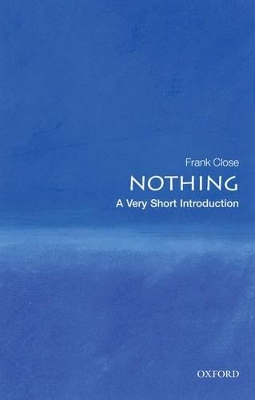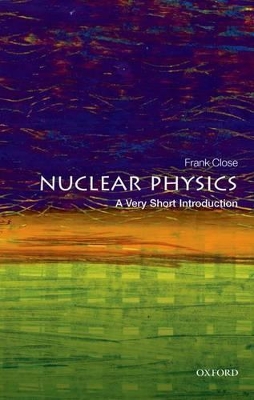Very Short Introductions
3 total works
In this compelling introduction to the fundamental particles that make up the universe, Frank Close takes us on a journey into the atom to examine known particles such as quarks, electrons, and the ghostly neutrino. Along the way he provides fascinating insights into how discoveries in particle physics have actually been made, and discusses how our picture of the world has been radically revised in the light of these developments. He concludes by looking ahead to new ideas about the mystery of antimatter, the number of dimensions that there might be in the universe, and to what the next 50 years of research might reveal.
ABOUT THE SERIES: The Very Short Introductions series from Oxford University Press contains hundreds of titles in almost every subject area. These pocket-sized books are the perfect way to get ahead in a new subject quickly. Our expert authors combine facts, analysis, perspective, new ideas, and enthusiasm to make interesting and challenging topics highly readable.
ABOUT THE SERIES: The Very Short Introductions series from Oxford University Press contains hundreds of titles in almost every subject area. These pocket-sized books are the perfect way to get ahead in a new subject quickly. Our expert authors combine facts, analysis, perspective, new ideas, and enthusiasm to make interesting and challenging topics highly readable.
What is 'nothing'? What remains when you take all the matter away? Can empty space - a void - exist? This Very Short Introduction explores the science and the history of the elusive void: from Aristotle who insisted that the vacuum was impossible, via the theories of Newton and Einstein, to our very latest discoveries and why they can tell us extraordinary things about the cosmos.
Frank Close tells the story of how scientists have explored the elusive void, and the rich discoveries that they have made there. He takes the reader on a lively and accessible history through ancient ideas and cultural superstitions to the frontiers of current research. He describes how scientists discovered that the vacuum is filled with fields; how Newton, Mach, and Einstein grappled with the nature of space and time; and how the mysterious 'aether' that was long ago supposed to permeate the
void may now be making a comeback with the latest research into the 'Higgs field'.
We now know that the vacuum is far from being empty - it seethes with virtual particles and antiparticles that erupt spontaneously into being, and it also may contain hidden dimensions that we were previously unaware of. These new discoveries may provide answers to some of cosmology's most fundamental questions: what lies outside the universe, and, if there was once nothing, then how did the universe begin?
ABOUT THE SERIES: The Very Short Introductions series from Oxford University Press contains hundreds of titles in almost every subject area. These pocket-sized books are the perfect way to get ahead in a new subject quickly. Our expert authors combine facts, analysis, perspective, new ideas, and enthusiasm to make interesting and challenging topics highly readable.
Frank Close tells the story of how scientists have explored the elusive void, and the rich discoveries that they have made there. He takes the reader on a lively and accessible history through ancient ideas and cultural superstitions to the frontiers of current research. He describes how scientists discovered that the vacuum is filled with fields; how Newton, Mach, and Einstein grappled with the nature of space and time; and how the mysterious 'aether' that was long ago supposed to permeate the
void may now be making a comeback with the latest research into the 'Higgs field'.
We now know that the vacuum is far from being empty - it seethes with virtual particles and antiparticles that erupt spontaneously into being, and it also may contain hidden dimensions that we were previously unaware of. These new discoveries may provide answers to some of cosmology's most fundamental questions: what lies outside the universe, and, if there was once nothing, then how did the universe begin?
ABOUT THE SERIES: The Very Short Introductions series from Oxford University Press contains hundreds of titles in almost every subject area. These pocket-sized books are the perfect way to get ahead in a new subject quickly. Our expert authors combine facts, analysis, perspective, new ideas, and enthusiasm to make interesting and challenging topics highly readable.
Nuclear physics began long before the identification of fundamental particles, with J. J. Thomson's discovery of the electron at the end of the 19th century, which implied the existence of a positive charge in the atom to make it neutral. In this Very Short Introduction Frank Close gives an account of how this area of physics has progressed, including the recognition of how heavy nuclei are built up in the cores of stars and in supernovae, the identification of quarks and gluons, and the development of quantum chromodynamics (QCD). Exploring key concepts such as the stability of different configurations of protons and neutrons in nuclei, Frank Close shows how nuclear physics brings the physics of the stars to Earth and provides us with important applications, particularly in medicine.
ABOUT THE SERIES: The Very Short Introductions series from Oxford University Press contains hundreds of titles in almost every subject area. These pocket-sized books are the perfect way to get ahead in a new subject quickly. Our expert authors combine facts, analysis, perspective, new ideas, and enthusiasm to make interesting and challenging topics highly readable.
ABOUT THE SERIES: The Very Short Introductions series from Oxford University Press contains hundreds of titles in almost every subject area. These pocket-sized books are the perfect way to get ahead in a new subject quickly. Our expert authors combine facts, analysis, perspective, new ideas, and enthusiasm to make interesting and challenging topics highly readable.


